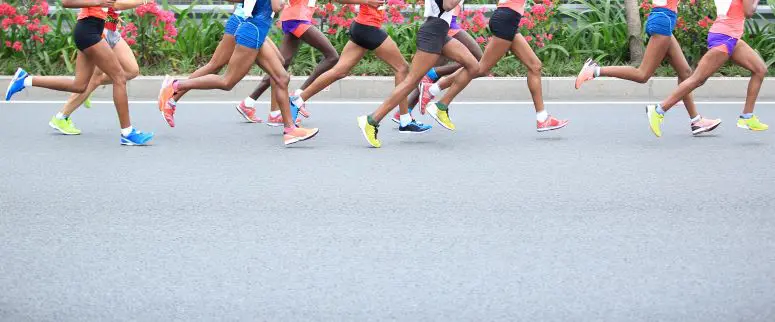Training for a marathon is difficult. A 26.2-mile footrace is not something the human body is designed to do. What’s more, few marathon runners are content to run a single marathon. The addictive and competitive nature of running compels a competitor to seek a faster time in at the next race. The issue is that recovery after a marathon or half marathon depends on your experience as a runner. Some people need weeks and some need much more. It is always a good thing to error on the side of caution.
In order to ensure future success as well as to remain injury-free, it is imperative that one properly recovers after the marathon and before beginning to train for the next one.
Keep in mind that complete recovery from a marathon takes one day for each mile of the race. So, a full month is required before the runner is healed from the marathon effort.
Immediate Post-Marathon Recovery
Recovery begins as soon as one crosses the finish line. A massive amount of body weight is lost, especially if the race has been run in warm weather. Immediate hydration is a must. Begin with water, then move to electrolyte drinks, if your stomach can tolerate them. You can enjoy your post-race beer and admire your medal if you want to since you earned it. But you really should avoid alcohol and caffeine drinks, as they increase dehydration.
A barometer of successful rehydration is simple: frequent and clear urine is the goal. As urine moves from a deep yellow to a clear color, the runner is beginning to rehydrate, and recovery has begun. For the next 24 hours, water is the marathon runner’s best friend.
By the time one reaches the final 10K of the marathon, some runners have depleted their glycogen supplies, and have begun to burn muscle. Your effort has turned your body into a blast furnace, so the fire must be fueled. Bananas for potassium to assist cramping muscles and adequate protein to repair damaged muscle. Proper nutrition is critical for recovery in the weeks after running a marathon.

Later on Race Day
Swelling and inflammation are reduced by cold temperatures. Ice baths and ice packs on specific areas of inflammation are excellent methods of reducing inflammation during the days after the race. You need to be careful with the ice bath as you should not be doing it for the first time post-race. You should do it after your longer, harder runs throughout your training. Ideally submerging your hips and legs after filling the tub with cold water. The water should be 50-60° and you can ice after you are already in to take away some of the shock. Filling the tub with ice first and then cold water can be too much of a shock to the system.
A foam roller for the lower back and a hard roller for the legs will break up sore muscles and are excellent recovery tools.
Marathon Recovery Post-Race Week
It seems as if we can never win after running a marathon. As runners, we are never satisfied with the outcome. If we run slower than we expected, we can’t wait to avenge our disappointment and run another marathon. But, if we run faster than expected, we know that, if we train a little harder, we can run faster next time.
On the day after the marathon, begin with making sure you are properly hydrated, and eat enough to replenish calories lost the day before.
Take at least a half hour to stretch out hamstrings, calves, quads and hips. Stretch slowly, and don’t bounce. Yoga stretches are very good. Make sure that you have scheduled a massage with your favorite massage therapist in the few days after your race.
There is absolutely no need to run or jog for the first few to several days after your marathon. A couple days of full rest is warranted. Quite often, two days after the marathon, soreness seems to increase. I recommend a second day of no running. Walk a bit longer, and at a brisk pace, if necessary. A brisk walk, or even a sightseeing stroll is enough to exercise sore muscles and joints.
As you return to your training, easy back gradually. Three days after the marathon, go slowly jog on a soft surface. Keep your mileage low and understand that you will fatigue quickly. When that fatigue sets in, shut it down. Do not push through it. The toughness that allows runners to complete a marathon is often the same toughness that causes them to drop from a race due to injury. Running through it is not a good idea. There is no need to prove that you are tough.
Those that have been injured should take more time off to recover as should first time marathoners.
Continued Marathon Recovery – Second Week to 1 month
In the days and weeks after the marathon, do not be afraid to cross train. For aerobic fitness, ride a bike outdoors, or ride an indoor exercise bike. Swimming is another excellent way to maintain your aerobic fitness level while allowing complete recovery of your legs.
Most runners do not like to stretch, but a stretching routine both before and after your workout is especially important in the weeks following a marathon.
Think of returning to running like a reverse taper but with less miles. Start out slow and only a few days per week and gradually increase time, intensity and frequency. Patience is something that most runners have little of, but patience will pay large dividends if you follow a cautious post-marathon training schedule.
Cool Your Jets
It is essential to resist the temptation to “get back on the horse,” and allow for complete recovery. If we do so, we stand a much better chance of achieving our future goals.
A week or so after the marathon, you may increase your running distance, but avoid hills, and remain on flat and soft surfaces. If you are an everyday runner, during the weeks after the marathon, supplement your running with cycling and/or swimming, and try running only three to four days a week. Also, avoid races, of any distance, for a month after the marathon. Running a race within a month of your marathon effort will do little but frustrate you, and it could lead to injury.
See your massage therapist and a chiropractor certified in sports medicine a few times in the month after your race. Both have the skills to help alleviate those nagging aches and pains. People with nagging problems can be evaluated and corrective exercise or other treatments might be given to alleviate persistent symptoms. Breakdowns in your mechanics from all those miles can be addressed by Graston Technique.

Conclusion
Finally, use the month after your marathon to reacquaint yourself with family and friends. Training for a marathon requires a large investment of time, which can sometimes take its toll on those around you. Give your family and friends a month of normalcy.
Having run a marathon, you have become a member of an exclusive club of individuals who have achieved an incredible feat of athletic endurance. If you allow for proper recovery, you will increase your chances of remaining healthy and strong enough to improve your marathon time. We both know that you have already planned it out.
Article Featured in Toledo Roadrunners Club Footprints Volume 46, Issue 4 (April 2020)
